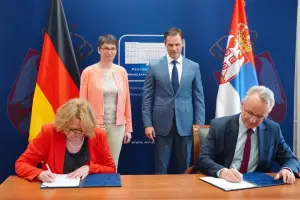- Serbia
Get to know Serbia
- Citizens
Culture and science
Health services
Pension and disability insurance
- Business
Employment
Economy
- Media
- Government
- Contact
Keep in touch
Contact form
Back
Keepin touch
Whether you have a question, comment, suggestion or any problem in the purview of the government, send us your message and we will try to respond as soon as possible. If your problem is not in our purview, we will forward your message to the relevant institution.
Q:
A:
January-May inflation rate stands at 3.6%
Belgrade,
31 May 2007
The Serbian Statistics Office stated today that May retail prices went up by 3.6% against December 2006.
According to the statement, prices of goods are up by over 1.4% against April 2007.
Serbia’s total foreign trade for the period January-April exceeded $7.7 billion and is up by 45.2% in comparison with the same period last year.
Goods worth $2.491 billion were exported, which makes up an increase of 48.1%, while imports stood at $5.231 billion, a rise by 43.8% against the same period in 2006.
The deficit stands at $2.739 billion, which is an increase of 40.1%.
The exports-to-imports ratio is currently 47.6% and is greater than in the same period last year when it stood at 46.2%.
Increased imports in the past period were a result of the import of energy sources, which makes 19.5% of the entire import. Import of copper and iron ores, used in the production of elementary and other metals, and which have a favourable price and increased demand (public and private spending) on the world market, also bore influence on the rise in imports.
Increased exports were driven by the initial effects of privatisation and the restructuring of companies, by signed and ratified free trade agreements with signatory countries of the Stability Pact, by food and ready-made garment industry surplus, as well as a favourable ratio between export and import prices.
The most exported items in this period were intermediate goods accounting for 68.7%, followed by consumer goods, which made up 24.8% and equipment, making up 6.5% of total exports.
Major importers of goods from Serbia were Italy, Bosnia-Herzegovina and Germany. The largest exporters to Serbia were Russia, Germany and Italy.
The greatest foreign trade was recorded in commerce with the EU, which accounted for more than half of total trade.
A foreign trade surplus was realised in commerce with Bosnia-Herzegovina, Macedonia, Austria, Montenegro and Slovenia. The largest trade deficit was in commerce with Russia due to the import of oil and gas.
Iron, steel, coloured metals, garments, metal products and wheat and products have the largest share in exports, and make up 37.6% of overall export.
The first five sections with the largest share in imports are oil and oil derivatives, road vehicles, natural and industrial gas, industrial machines for general use and iron and steel and their export makes up 33.4% of overall export.
Serbia’s total foreign trade for the period January-April exceeded $7.7 billion and is up by 45.2% in comparison with the same period last year.
Goods worth $2.491 billion were exported, which makes up an increase of 48.1%, while imports stood at $5.231 billion, a rise by 43.8% against the same period in 2006.
The deficit stands at $2.739 billion, which is an increase of 40.1%.
The exports-to-imports ratio is currently 47.6% and is greater than in the same period last year when it stood at 46.2%.
Increased imports in the past period were a result of the import of energy sources, which makes 19.5% of the entire import. Import of copper and iron ores, used in the production of elementary and other metals, and which have a favourable price and increased demand (public and private spending) on the world market, also bore influence on the rise in imports.
Increased exports were driven by the initial effects of privatisation and the restructuring of companies, by signed and ratified free trade agreements with signatory countries of the Stability Pact, by food and ready-made garment industry surplus, as well as a favourable ratio between export and import prices.
The most exported items in this period were intermediate goods accounting for 68.7%, followed by consumer goods, which made up 24.8% and equipment, making up 6.5% of total exports.
Major importers of goods from Serbia were Italy, Bosnia-Herzegovina and Germany. The largest exporters to Serbia were Russia, Germany and Italy.
The greatest foreign trade was recorded in commerce with the EU, which accounted for more than half of total trade.
A foreign trade surplus was realised in commerce with Bosnia-Herzegovina, Macedonia, Austria, Montenegro and Slovenia. The largest trade deficit was in commerce with Russia due to the import of oil and gas.
Iron, steel, coloured metals, garments, metal products and wheat and products have the largest share in exports, and make up 37.6% of overall export.
The first five sections with the largest share in imports are oil and oil derivatives, road vehicles, natural and industrial gas, industrial machines for general use and iron and steel and their export makes up 33.4% of overall export.
-
 Belgrade, 21 July 2025
Belgrade, 21 July 2025Construction of oil pipeline with Hungary to begin early next year
-
 Belgrade/Athens, 17 July 2025
Belgrade/Athens, 17 July 2025Serbia continues to align with EU in field of energy
-
 Kostolac, 14 July 2025
Kostolac, 14 July 2025First solar power plant Petka in Kostolac put into trial operation
-
 Belgrade, 11 July 2025
Belgrade, 11 July 2025Potential for improving cooperation with Belarus in many areas
-
 Požega, 5 July 2025
Požega, 5 July 2025Section of Pakovraće - Požega highway officially opened
-
 Belgrade, 2 July 2025
Belgrade, 2 July 2025Technical specifications defined for Serbia-Hungary oil pipeline
-
 Belgrade, 30 June 2025
Belgrade, 30 June 2025IMF confirms Serbia successfully implementing all agreed reforms
-
 Belgrade, 27 June 2025
Belgrade, 27 June 2025Double Taxation Avoidance Agreement with Germany signed
-
 Kostolac, 25 June 2025
Kostolac, 25 June 2025Construction of Kostolac wind farm nearing completion
-
 Belgrade, 24 June 2025
Belgrade, 24 June 2025Government supports request for new postponement of sanctions against NIS
